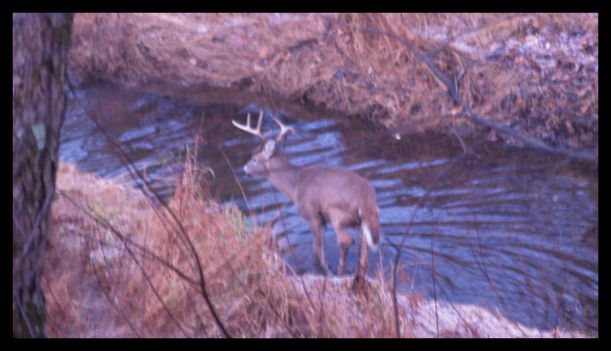
Often male deer, bucks, rub their antlers on trees planted in the urban environment. While this is an important practice for the buck, you will want to avoid this on a tree you have paid to correctly plant. More should be discussed about the long term result of such injury, such as the creation of a unique future habitat and possibly a niche.
 This pine tree
in this photo had a serious
wound or injury
when it was much younger. The tree set boundaries and among other
interactions of
microorganisms and organisms,
carpenter ants
created ant galleries within the wood that was present at the time of
wounding. The ants often respect the
boundaries set by the
tree. Eventually the pileated woodpeckers arrived and created cavities
as they excavated for the ants. This work then created a
habitat and possibly a
niche for
flying
squirrels to live and raise young. My point - what seems like a
worthless interaction can result in wonderful things in time. There is
so much we do not understand. See "Managing
Trees For Wildlife".
This pine tree
in this photo had a serious
wound or injury
when it was much younger. The tree set boundaries and among other
interactions of
microorganisms and organisms,
carpenter ants
created ant galleries within the wood that was present at the time of
wounding. The ants often respect the
boundaries set by the
tree. Eventually the pileated woodpeckers arrived and created cavities
as they excavated for the ants. This work then created a
habitat and possibly a
niche for
flying
squirrels to live and raise young. My point - what seems like a
worthless interaction can result in wonderful things in time. There is
so much we do not understand. See "Managing
Trees For Wildlife".
I believe you should say five positive things about any organism before you criticize it.
I believe that ecoart nurse logs deterred bucks from damaging a tree I planted in a deer populated area. Another tree which I planted, a Paper Bark Maple, was to be deer resistant. Although I planted it with ecoart logs, they were removed by the client. This tree was planted in an area less populated by deer, but it was hit harder.
There are two ways to install other protection if you choose. Avoid wrapping or placing products around trunks that will block the sun's energy from reaching the green cortex of the trunk. Fencing allows sunlight to reach the tree so it can manufacture "Tree Food" or "Plant Food." Trees manufacture their own food. You cannot buy tree food in a store. People apply essential elements they believe are lacking. In my opinion, this practice is often wrong. People often focus on applying large does of nitrogen, as if, we are fertilizing corn. There are 17 essential elements, i.e., if you count nickel as essential. There is controversy at this time between researchers of the term essential. Researchers at Penn State, with their special equipment, were able to detect nickel in plants. Therefore, my professor and I, consider nickel as essential in very small amounts. Whenever one of the 17 are lacking, it will determine the health of the tree. If we add nitrogen it will allow more growth. However what people must understand, is that with a bigger symplast, you increase the demands on the soil for the other 13 essential elements and water, that come from the soil, in order to maintain system health. 14 of the 17 essential elements come from the soil.. The last thing you want to do to a mature tree is sock it with nitrogen and make it grow bigger, greener and faster.
Here are
two articles by Dr. Shigo, touching the subject.
1. Troubles
in the Rhizosphere
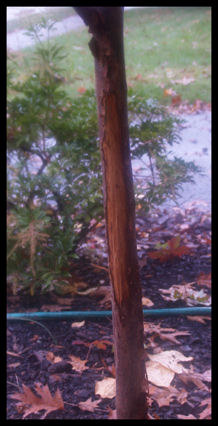
Here is the injury from the buck on the maple with ecoart-nurse logs removed. In other words "The Wood Cut Out"!
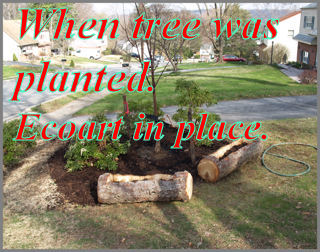
Note: It is important to "treat the system" and not just the wound. Proper mulching as well as proper fertilization and watering are some treatments of the system for starters.
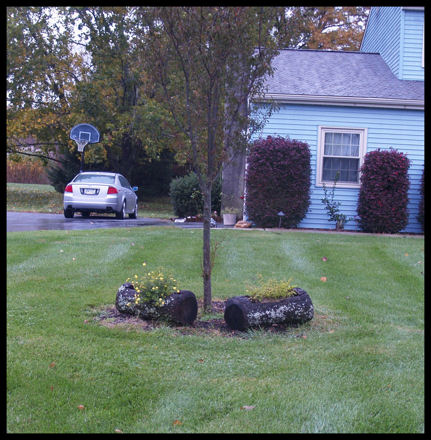
Here is a cherry tree where the buck did not rub. It may have been visited, but I believe the deer resistant flowers in the ecoart nurse logs and the logs themselves are responsible for the tree's condition.
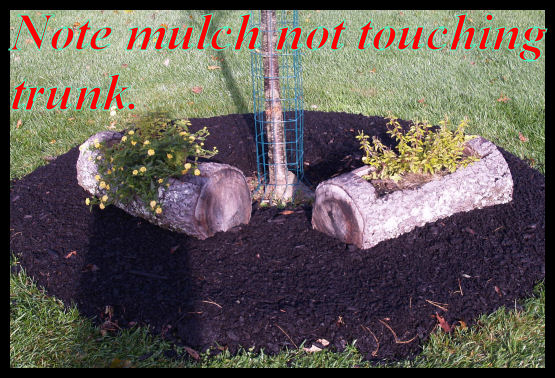
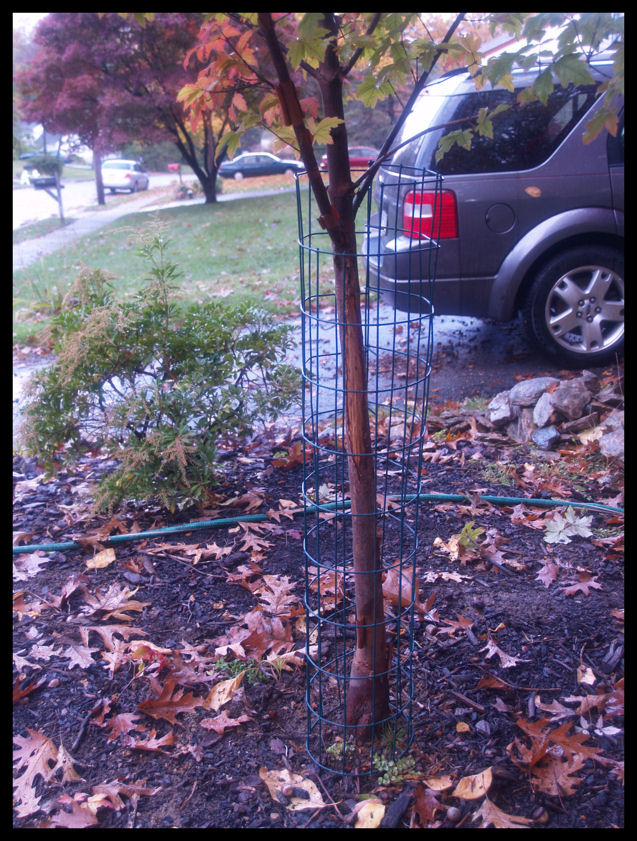
Here is another way to place protection around a tree. Careful not to allow fence to injure tree. Also, it would be best if the device does not block the sunlight energy from being trapped by the green cortex of the trunk of young trees. Note: During winter when temperature rises above 40 degrees f. photosynthesis begins again. Traditional tree wrap blocks that sunlight energy thus taking potential food from the tree and its associates, above and below ground. It is important to recognize that when there are no leaves on the tree, the young tree still maintains a green cortex enveloping the trunk of the tree. The tree can photosynthesis at that time. Water for the process would come from bound water. The exchanging of gases would be facilitated by the lenticular spots or lenticels. There is so much we do not know about natural systems.
Did you know that a sycamore or London plane trees can
survive a year without leaves? As the tree
sheds its outer
 phellem
a green cortex envelops the entire tree like a big leaf.
phellem
a green cortex envelops the entire tree like a big leaf.
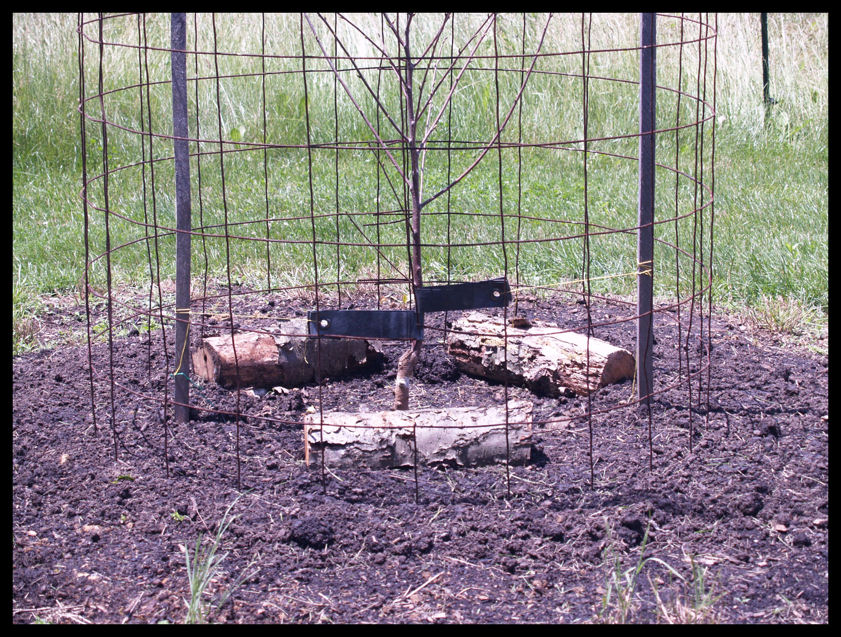
Here is another method which works for buck, as well as browsing issues. This was a bare root cherry we planted this year.
Share your thoughts and stories. I believe it would be best to work with nature using ecoart-nurse logs.
Eco = Ecology
Art = Art
Nurse Log = They nurse the system, a log bigger than 1.5 feet in diameter and at least 4 feet long with soil contact. For much more on the value of fallen trees and wood, with respect to ecosystem or forest health, see "Messy Forestry" or Our Technical pages.
Dictionary MAIN
PAGE
Text & Graphics Copyright © 2009
Keslick & Son Modern Arboriculture
Please report web site problems, comments and words of interest,
not found.
Contact